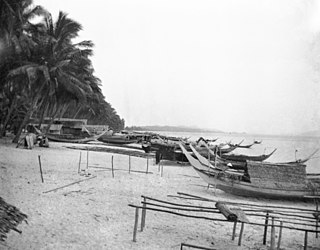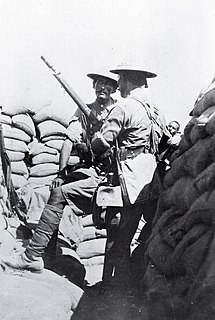
The 4th Indian Infantry Division, also known as the Red Eagle Division, is the infantry division of the Indian Army. This division of the British Indian Army was formed in Egypt in 1939 during the Second World War. During the Second World War, it took part in campaigns in East Africa, Syria, North Africa and Italy. Post independence, the division is part of the I Corps and headquartered at Prayagraj.

The 1st Commonwealth Division was the name given, after July 1951, to Commonwealth land forces in the Korean War. The division was a multinational unit that was part of British Commonwealth Forces Korea, and whilst British, Canadian Army and Australian infantry units formed the bulk of the division, New Zealand artillery and an Indian medical unit were also a part of the division. As with the US "KATUSA" programme, numerous South Korean troops were seconded to the Commonwealth division to make up numbers under a programme known as "KATCOM".

Operation Krohcol, or the Battle for The Ledge, was a British operation in December 1941 to invade southern Thailand following the Japanese invasion of Malaya and of Thailand during World War II. It was authorised by Lieutenant-General Arthur Percival as a "mini Matador" after Operation Matador, a pre-emptive strike into Thailand which had been opposed by the British government and was not carried out. Due to delays in authorisation by Percival and in the forwarding of his order, the need to reorganise the troops for Krohcol instead of Matador, and resistance from Thai policemen the Krohcol column did not reach the Ledge in time.

The Punjab Regiment is second oldest regiments still in service in the Indian Army, and is the most senior regional infantry regiment. It was formed from the 2nd Punjab Regiment of the British Indian Army in 1947 and has taken part in various battles and wars since, winning numerous honours for the same.
Major-General Arthur Edward "Bustling Bill" Barstow, was a British Indian Army officer who commanded the 9th Indian Division during the Battle of Malaya. He was killed by the Japanese on active service in 1942 while trying to cross a demolished railway bridge near Layang Layang village.

The 12th Frontier Force Regiment was formed in 1922 as part of the British Indian Army. It consisted of five regular battalions; numbered 1 to 5 and the 10th (Training) Battalion. During the Second World War a further ten battalions were raised. In 1945, the prenominal "12th" was dropped when the British Indian Army dispensed with prenominal numbering of its regiments. After the independence in 1947, it was formed into the Frontier Force Regiment, part of the army of Pakistan.
The Malaya Command was a formation of the British Army formed in the 1920s for the coordination of the defences of British Malaya, which comprised the Straits Settlements, the Federated Malay States and the Unfederated Malay States. It consisted mainly of small garrison forces in Kuala Lumpur, Penang, Taiping, Seremban and Singapore.
The 4th Regiment, Royal Australian Artillery is an artillery unit of the Australian Army. Currently it provides close artillery support to the 3rd Brigade and is based at Chau Pha Lines, Lavarack Barracks in Townsville, Queensland. The regiment was raised in its current form in 1960 and is currently re-equipping with M777A2 lightweight towed howitzers. The regiment deployed during Australia's commitment to the Vietnam War and has subsequently deployed to Singapore and East Timor.
The 11th Indian Infantry Division was an infantry division of the Indian Army during World War II. It formed part of Indian III Corps in the Malaya Command during the Battle of Malaya. The division was re-raised on 1 April 1965 and is presently part of the XII Corps of Southern Command. It is presently responsible for safeguarding the borders with Pakistan along Southern Rajasthan and Gujarat.

The Japanese Invasion of Malaya began just after midnight on 8 December 1941 before the attack on Pearl Harbor. It was the first major battle of the Pacific War, and was fought between ground forces of the British Indian Army and the Empire of Japan.

The 25th Indian Infantry Division was an infantry division of the Indian Army during World War II which fought in the Burma Campaign. It was re-raised within the post-independence Indian Army in 1948.

The 7th (Meerut) Division was an infantry division of the British Indian Army that saw active service during World War I.
The 3rd (Lahore) Division was an infantry division of the British Indian Army, first organised in 1852. It saw service during World War I as part of the Indian Corps in France before being moved to the Middle East where it fought against troops of the Ottoman Empire.
The Japanese Imperial Army landed the 25th Army under the command of General Tomoyuki Yamashita on the east coasts of Malaya and Thailand on the night of 7 December 1941.

75th Division was an infantry division of the British Army in World War I. It was raised in the field by the Egyptian Expeditionary Force (EEF) in 1917 and it included British, Indian and South African troops. It served in the Middle East during the Sinai and Palestine Campaign being involved in the Battles of Megiddo.
The Rawalpindi Parade 1905 was a parade by the British Indian Army held in Rawalpindi, India on 8 December 1905 to honour the Prince and Princess of Wales. The troops were under the Command of Horatio Herbert, Viscount Kitchener of Khartoum, G.C.B., O.M., G.C.M.G., Commander-in-Chief India. The Royal party arrived at the parade ground escorted by a Field Officer's escort of 1st Skinner's Horse. They then received a Royal salute and inspected the troops, accompanied by the Commander-in-chief. On conclusion of the inspection, the troops on parade marched past in the following order.
The Burma Corps ('Burcorps') was an Army Corps of the Indian Army during World War II. It was formed in Prome, Burma, on 19 March 1942, took part in the retreat through Burma, and was disbanded on arrival in India in May 1942.
The 28th Indian Infantry Brigade was an infantry brigade formation of the Indian Army during World War II. The brigade was formed in March 1941, at Secunderabad in India and assigned to the 6th Indian Infantry Division. In September 1941, the brigade was sent to Malaya. Coming under command III Indian Corps and 11th Indian Infantry Division the brigade surrendered with the rest of the Commonwealth forces during the Battle of Singapore on 15 February 1942.

The 4th Lancashire Artillery Volunteers, later renamed to the 4th West Lancashire Brigade, known as 'The Old 4th', was a part-time unit of the British Army's Royal Artillery founded in Liverpool in 1859. It served on the Western Front during World War I, one of its members winning the Victoria Cross at Cambrai. Between the world wars the unit pioneered mechanical traction methods. During World War II it formed three regiments that saw action at Dunkirk, in East Africa, on Crete, at Tobruk, in Burma, and in the final campaigns in Italy and North West Europe. It continued in the post-war Territorial Army until 1973.

The 54th Infantry Division is an Infantry division of the Indian Army. The Division was raised as an Infantry Division, but was converted into a Reorganised Amphibious Formation (RAMFOR) in 2011. It is currently the only division of the Indian Army which carries out Amphibious warfare. The division is headquartered at Secunderabad in Telangana and is a part of XXI Corps. The Division is commanded by a Two-star General Officer of the rank of Major General titled General Officer Commanding (GOC).











